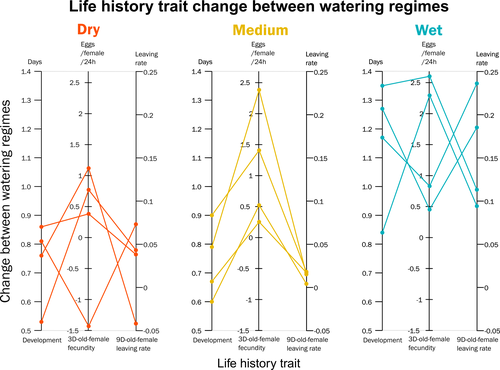
CASTAGNEYROL Bastien
- BIOGECO, INRA, Bordeaux, France
- Biodiversity, Ecology
- recommender
Recommendations: 0
Review: 1
Review: 1

Climate of origin influences how a herbivorous mite responds to drought-stressed host plants
Not all spider-mites respond in the same way to drought
Recommended by Inês Fragata and Raul Costa-Pereira based on reviews by Bastien Castagneyrol and 2 anonymous reviewersBiotic interactions are often shaped by abiotic factors (Liu and Gaines 2022). Although this notion is not new in ecology and evolutionary biology, we are still far from a thorough understanding of how biotic interactions change along abiotic gradients in space and time. This is particularly challenging because abiotic factors can affect organisms and their interactions in multiple – direct or indirect – ways. For example, because abiotic conditions strongly determine how energy enters biological systems via producers, their effects can propagate through entire food webs, from the bottom to the top (O’Connor 2009, Gilbert et al 2019). Understanding how biological diversity - both within and across species - is shaped by the indirect effects of environmental conditions is a timely question as climate change and anthropogenic activities have been altering temperature and water availability across different ecosystems.
Motivated by the current water crisis and severe droughts predicted for the near future worldwide (du Plessis 2019), Migeon et al. (2023) investigated how water limitation on producers scales up to affect life-history patterns of a widespread crop pest, the spider mite Tetranychus urticae. The authors sampled spider mite populations (n = 12) along a striking gradient of climatic conditions (>16 degrees of latitude) in Europe. After letting mites acclimate to lab conditions for several generations, the authors performed a common garden experiment to quantify how the life-history traits of mite populations from different locations respond to drought stress in their host plants.
Curiously, the authors found that, when reared on drought-stressed plants, mites tended to develop faster, had higher fecundity and lower dispersion rates. This response was in line with some results obtained previously with Tetranychus species (e.g. Ximénez-Embun et al 2016). Importantly, despite some experimental caveats in the experimental design, which makes it difficult to completely disentangle the specific effects of location vs. environmental noise, results suggest the climate that populations originally experienced was also an important determinant of the plastic response in these herbivores. In fact, populations from wetter and colder regions showed a steeper change in drought response, while populations from arid climates showed a shallower response. This interesting result suggests the importance of intraspecific (between-populations) variation in the response to drought, which might be explained by the climatic heterogeneity in space throughout the evolutionary history of different populations. These results become even more important in our rapidly changing world, highlighting the importance of considering genetic variation (and conditions that generate it) when predicting plastic and evolutionary responses to stressful conditions.
REFERENCES
du Plessis, A. (2019). Current and Future Water Scarcity and Stress. In: Water as an Inescapable Risk. Springer Water. Springer, Cham. https://doi.org/10.1007/978-3-030-03186-2
Gibert, J.P. Temperature directly and indirectly influences food web structure. Sci Rep 9, 5312 (2019). https://doi.org/10.1038/s41598-019-41783-0
Liu, O. R., & Gaines, S. D. (2022). Environmental context dependency in species interactions. Proceedings of the National Academy of Sciences, 119(36), e2118539119. https://doi.org/10.1073/pnas.2118539119
Migeon A., Auger P., Fossati-Gaschignard O., Hufbauer R.A, Miranda M., Zriki G., Navajas M. (2023) The response to drought-stressed host plants varies among herbivorous mite populations from a climate gradient. bioRxiv, 2021.10.21.465244, ver. 4 peer-reviewed and recommended by Peer Community in Zoology. https://doi.org/10.1101/2021.10.21.465244
O'Connor, M.I. (2009), Warming strengthens an herbivore-plant interaction. Ecology, 90: 388-398. https://doi.org/10.1890/08-0034.1
Ximénez-Embún, M. G., Ortego, F., & Castañera, P. (2016). Drought-stressed tomato plants trigger bottom-up effects on the invasive Tetranychus evansi. PloS one, 11(1), e0145275. https://doi.org/10.1371/journal.pone.0145275